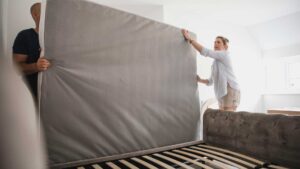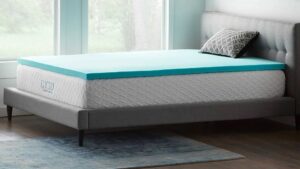How thick should your mattress be? A memory foam mattress with a thickness of 10 to 14 inches will provide good support for your body. Thinner memory foam mattresses may not be as supportive, resulting in sagging after a few years.
There’s a memory foam mattress for everyone, whether you prefer to sleep on a firm surface or sink into luscious softness. The feel of a memory foam mattress is affected by factors such as thickness and density.
Price, the kind of sheets you use, and overall comfort can all be affected by thickness. We’ll tell you how to select the appropriate thickness for your next memory foam mattress. If you’re looking for a new mattress check out our Puffy mattress review.
Mattress Thickness Guide
What memory foam mattress thickness do you need? They can be anywhere from 8 and 14 inches long. The normal mattress thickness is 10 to 12 inches, which is sufficient to fit to the body of an adult sleeper. Another way to get more support is to buy a thicker mattress.
These considerations can impact whether you should try a 10-inch thick mattress or a 14-inch thick mattress if you’re wondering what thickness memory foam mattress is ideal.
- Do you sleep with a partner?
- Body type
- Bed height
- Back pain or neck pain
- Sleeping position
While thickness is a good place to start, you’ll also want to conduct some research on your possible mattress to make sure it satisfies all of your sleep requirements.
Choose a thicker mattress if you require extra support.
Mattress Thickness Choices
The majority of high-quality mattresses are 8 to 14 inches thick. Mattress thickness is not governed by any regulations. Here’s a list of common thicknesses.
- 2 – 5 inches: Low profile mattresses
- 5 – 8 inches: Slim mattresses
- 8 – 12 inches: Standard mattresses
- 12 – 16 inches: Thick, deep, or tall mattresses
- More than 16 inches: Extra thick, extra deep, or extra tall mattresses
Slim mattresses have multiple layers of foam for added comfort and durability. These mattresses are more comfortable for adults and are an excellent choice for folks with limited mobility who want to avoid hefty mattresses.
Mattress Construction and Mattress Thickness
The thickness of each of the layers inside a mattress determines its depth. The majority of mattresses have two layers, however high-quality mattresses might have three, four, or even more layers. Different materials are used in each layer.
The cushioning, stability, and longevity of your mattress are all affected by these materials. The comfort layer and the base layer are the two essential layers found in all mattresses.
So, what is the number of layers in a memory foam mattress? It depends on the brand and manufacturer, but there are usually two layers: a comfort layer and a base layer.
- Base Layer: Everything is supported by this lowest layer. To avoid sagging, it is made of durable materials.
- Comfort Layer: This top layer molds to your body’s shape and relieves pressure. It’s made of supple memory foam.
A transitional layer between the comfort and base layers is sometimes included in these mattresses. This center section functions as a buffer and prevents sagging.
What thickness memory foam mattress topper is best for you depends on how firm and supportive you want your mattress to be, but one thing is certain: you’ll need more base layer than comfort layer.

How to Choose Mattress Thickness
If you want one of the most durable mattresses that will last for years, it should be at least 8 inches thick, with a 5 or 6-inch thick base layer as a minimum.
The softer a mattress feels, the thicker it is. Here are some things to think about when choosing a mattress thickness.
Sleep Position
The feel of the mattress varies depending on its thickness, which has an impact on your sleep quality regardless of your sleeping position.
Some sleeping postures require more padding, whereas others require more support. Mattresses of various thickness levels can accommodate these various sleeping requirements.
- Side Sleepers: Side sleepers benefit from mattresses that are 12 to 14 inches thick and provide ample of cushioning for their shoulders and hips. In the side sleeping position, these areas carry the weight of your entire body. The soft comfort layers provide the necessary padding to alleviate discomfort in the shoulders and hips.
- Stomach Sleepers: Mattresses with a thickness of 10 inches are recommended for stomach sleepers to avoid spinal misalignment. A firmer sleeping surface is provided by mattresses with a thinner comfort layer, which resists compression beneath your abdomen.
- Back Sleepers: Back sleepers require mattresses that are 10 to 12 inches thick to support the natural curve of their spine and avoid spinal misalignment. Back discomfort, neck aching, and muscle stiffness are all caused or aggravated by spinal misalignment. A mattress with a substantial foundation layer and a thinner comfort layer that is 10 to 12 inches tall can support your back and prevent sinking.
- Combination Sleepers: Mattresses with a 12-inch thickness and a medium feel are often comfortable for combination sleepers. Because combo sleepers alternate between sleeping on their sides, backs, and stomachs throughout the night, they require a mattress that strikes a balance between hardness and softness.
Body Type
How your mattress responds to your body weight is determined by the thickness of the mattress and the materials utilized. You should choose a mattress that is supportive enough for a restful night’s sleep, and your weight plays a role in this decision.
For lighter persons, mattresses that are 12 inches tall or thicker are a suitable choice. The thicker comfort layers contour to their bodies, minimizing aches and pressure areas.
Depending on their sleeping posture, average-weight sleepers can choose between 10 to 12-inch thick mattresses. Check the material used to construct each of the layers when purchasing a thick mattress to learn how they effect the feel of your mattress. A medium bed is suitable for people of average weight.
Heavyweight sleepers should go for a mattress that is 12 to 14 inches thick, with a comfort layer that is at least 6 inches thick. Mattress sinking can be avoided by using thicker comfort layers with enough give.
Sleepers With Back Pain or Neck Pain
People who suffer from back problems, for example, may want firmer mattresses with thinner comfort layers. These are sturdy enough to support your back while remaining soft enough to adjust to your spine’s natural curvature, alleviating back pain.
For more cushioning, those with arthritis may want softer beds. Mattresses with a thickness of 12 to 14 inches are a decent choice. Plusher comfort layers on thicker mattresses adjust to your curves, easing pressure areas.
Bed Frame Height
Consider the height of your box spring, foundation, platform, or adjustable bed when choosing the thickness of your new mattress.
Your bed’s entire height, including the bed base and mattress, should not exceed 25 inches. It may be difficult for people with limited mobility, such as back discomfort or joint pain, to get into and out of taller beds.
Pro and Cons of a Thick Mattress
Thick mattresses are usually softer than thin mattresses, and they give a more comfortable surface for the hips and shoulders. Thick mattresses, on the other hand, might be heavier and more expensive. Consider the thickness of each layer and how it affects the mattress’s feel while shopping for a new bed.
Advantages
- More cushioning is provided by thicker mattresses, which is especially beneficial for side sleepers.
- Thicker mattresses can support two adults’ weight, whereas thinner mattresses may sag.
Disadvantages
- Thicker mattresses are more expensive because they’re made of more materials.
- Because of the additional layers, the mattress is heavier, making it difficult to lift while making the bed or transporting it to another room or location.
- Thicker beds may end up being overly tall, making getting in and out of bed difficult for persons with limited mobility.
Mattress Firmness and Density as Factors
The more dense the mattress, the better it can support your body. A memory foam mattress’ density is expressed in pounds per cubic square foot, or PCF.
While low density mattresses are lighter and less expensive than higher density mattresses, greater density mattresses provide more support and durability.
It’s ideal to get a mattress with at least a medium-density rating. Anything lower can aggravate your neck and backaches, as well as cause you to break down more quickly.
Look at a mattress’s Indentation Load Deflection (ILD) rating to see how firm it is. Manufacturers of mattresses determine how much pressure a mattress can withstand before sinking four inches into the surface.
A mattress with a high rating is firm, whereas one with a low rating is soft. Choose the one that best fits your sleeping habits.
FAQ
How thick should a mattress be for a platform bed?
Low profile beds require mattresses that are 14 inches thick or greater. For normal platform beds, 10 to 12-inch mattresses will adequate. Back sleepers who require a solid base will benefit from firmer mattresses.
Is an 8 inch mattress thick enough?
Mattresses typically range in thickness from 8 to 14 inches. A comfort layer of at least 2-3 inches thick and a base layer of at least 6-8 inches thick are required for the greatest mattress.
Does thickness matter in memory foam mattress?
Thick mattresses are generally softer than thin mattresses. Choosing a thinner choice, on the other hand, will not detract from the inherent comfort of a memory foam mattress. The basic support structure is the foundation foam, and each subsequent level provides greater softness.
Is thicker memory foam better?
In general, the higher the density of memory foam, the higher the quality. Low-density memory foam is softer and less supportive, but high-density memory foam is firmer and lasts longer. The challenge to selecting a mattress is to strike a balance between your sleeping preferences and your budget.
Which is better 8 inch or 10 inch memory foam mattress?
When it comes to mattress thickness, bigger isn’t always better. The thickness of your mattress is determined by your size, sleeping position, mobility, and other things. We recommend an 8 to 10 inch mattress with a 2 to 4 inch comfort layer and a 5 to 6 inch support layer for nighttime use.
Which is better 6 inch or 8 inch mattress?
Most mattresses should be between 7-8 inches thick, and a thicker mattress is always preferable to one that is 5-6 inches thick. The comfort layer is normally 3 or 4 inches thick in 7-8 inch thick mattresses, and the support layer is 3-5 inches thick.
What is the difference in mattress thickness?
Slim mattresses are 5 to 8 inches. Standard mattresses are eight to 12 inches. Deep, thick, or tall mattresses are 12 to 16 inches. Extra deep, extra thick, or extra tall mattresses are more than 16 inches.
What thickness memory foam mattress is best?
High-quality memory foam mattresses with a thickness of 10 to 14 inches can give body conforming support. They are long-lasting, lasting between 10 and 15 years. Thinner memory foam mattresses may not be as supportive or long-lasting, developing soft areas and sags after three to four years.



